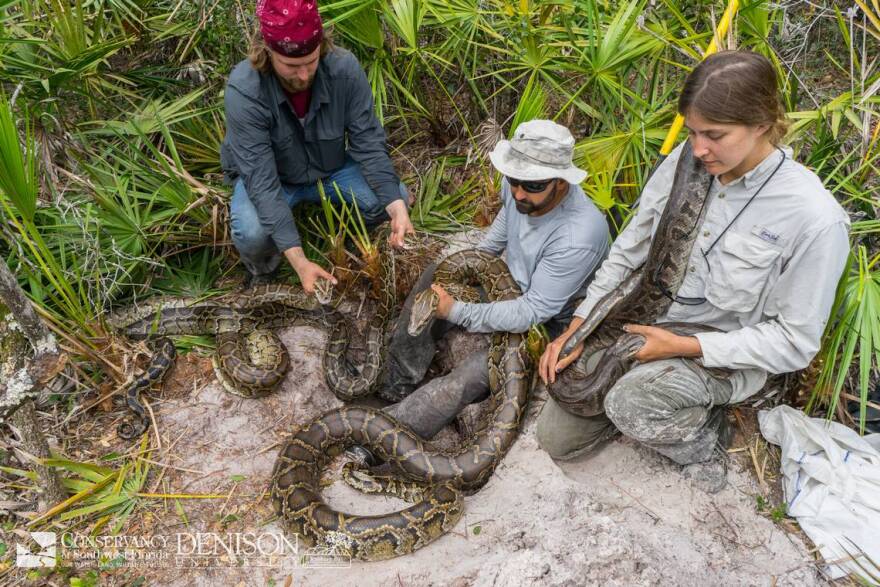Wildlife researchers studying mammals in Key Largo have discovered a potentially groundbreaking — if not heartbreaking — way to locate and kill invasive Burmese pythons, especially the big ones.
A team observing racoon and possum behavior along urban and wilderness fringe of Crocodile National Wildlife Refuge fitted dozens of the mammals with GPS collars, and tracked their locations for months.
In September, about five months into the study, one of the possum collars sent out a mortality signal, triggered by lack of movement — maybe it was hit by a car, maybe a local dog killed it. But then, a few hours later, the collar started moving again.
READ MORE: Florida wildlife officials want more funding to target invasive pythons
The researchers had a hunch that the possum suffered a brutal fate.
“That’s the signature signal that they got eaten by a snake,” said Michael Cove, curator of mammals at the North Carolina Museum of Natural Sciences, one of the partners on the study. He and his research partners from the U.S. Fish & Wildlife Service and Southern Illinois University suspected the snake sat around and digested the possum, and then started moving again.
But even with the tracker, it would take them time to confirm their hunch — Key Largo is essentially a giant fossilized coral reef with a labyrinth of underground pockets and caves. “This thing was underground. It took a month of tracking the snake underground (to capture it).”
When they finally yanked it out of the ground, they discovered a 12-foot-long, 66-pound female full of egg follicles. Large females like this can lay close to 100 eggs, and are the holy grail for python hunters. Removing them from the ecosystem is like removing dozens, if not hundreds, of future snakes. The team euthanized her, opened her up and retrieved the collar, which they hope to fit onto another possum soon.

Though the possum’s demise was grim — pythons coil around their prey, tightening the grip every time the animal exhales, eventually suffocating it — the death proved that wildlife officials can find big pythons by tracking their prey.
Cove and his research partners hope the method can help control the explosive population growth of the invasive snake, which has decimated ecosystems in South Florida for decades. Indigenous to southeast Asia, Burmese pythons likely slithered their way into the Everglades in the 1990s via the exotic pet trade.
READ MORE: It takes a python to find a python: How researchers bagged the heaviest snake in Florida history
They’ve thrived, establishing breeding populations as far south as Key Largo and as far north at the Loxahatchee National Wildlife Refuge in western Palm Beach County.
Cove said that the problem is so severe in Everglades National Park that “there are no more mammals to put these collars on.” The largest invasive python ever recorded in Florida was 18 feet long.
Proof of concept, and a glitch
The study occurred on the boundary between the human world and wilderness, and looked at what happens when raccoons and possums are “dumpster diving and eating all the cat food that people put out for them instead of eating the native seeds and fruits,” Cove said.
Both species consume a lot of native fruits and defecate the seeds out in different areas, becoming important seed dispersers.
A parallel goal, though, was to learn more about pythons if the mammals were eaten.
“If we could catch a snake in the act, it could lead to management and removal of the pythons,” Cove said.
The first possum was proof of concept — the collar survived the crush of the snake, and the snake didn’t pass the collar, giving the scientists time to find it.
Two weeks ago, a second collar stopped moving, then started again, indicating that a big raccoon had been eaten by a snake. This time they found the snake more quickly: jackpot, a 77-pound behemoth also full of egg follicles.
On Wednesday, yet another collar emitted a mortality signal and started moving again. But by the time researchers reached the tracker, all they found was a collar in a pile of snake poop. The python, apparently one massive enough to pass the device, was still out there.
“This was really crushing to me that we didn’t pull out this giant monster snake that ate this latest opossum,” Cove said. They now know that there’s a sense of urgency, especially if the snake is large enough to pass the collar.
Of the 43 collars they’ve deployed, they know three were ingested by pythons, but six more have simply disappeared. The research team now wonders if they were consumed by pythons who then moved beyond the study’s geographic range.
Cruel or crucial?
Is tracking prey to find pythons tantamount to using innocent racoons and possums as bait?
“That’s a question we’re getting — don’t you feel guilty for putting these animals at risk?” Cove said.
He said the collared animals are not at greater risk — they go about their business as they normally would, and researchers ensure the collars don’t hinder their movements. Unfortunately the pythons sometimes intercept them.
“We’re not doing anything but observing the animals doing their natural thing, and they’re unfortunately getting consumed and it’s leading to these python removals,” he said.
As it stands, no one has invented an effective way to remove invasive pythons.
Authorities have tried myriad methods, including tracking them with beagles, holding a python-catching derby called Python Challenge — last year’s 10-day challenge resulted in 231 snakes killed, a small fraction of the “tens of thousands” the U.S. Geological Survey estimates are lurking wild in the state.
Copyright 2023 WLRN 91.3 FM. To see more, visit WLRN 91.3 FM. 9(MDA4MzM1MjM1MDEzMTg5NTk0MzNmOTQ5MA004))

